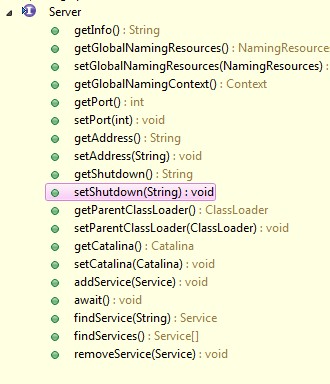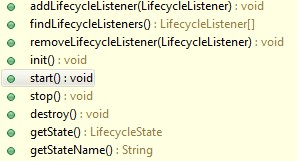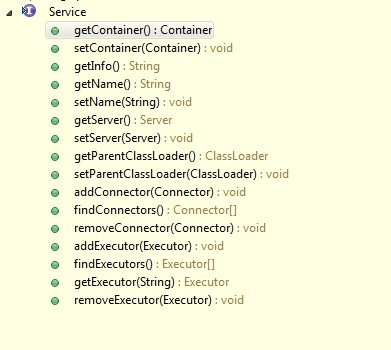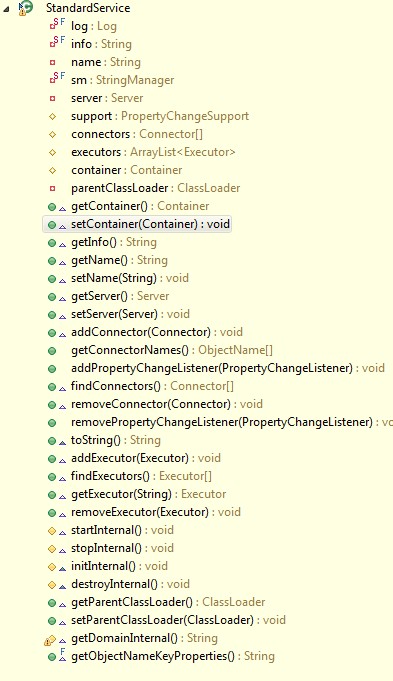本文共 7113 字,大约阅读时间需要 23 分钟。
前言
Tomcat是Apache基金组织下的开源项目,性质是一个Web服务器。下面这种情况很普遍:在eclipse床架一个web项目并部署到Tomcat中,启动tomcat,在浏览器中输入一个类似http://localhost:8080/webproject/anyname.jsp的url,然后就可以看到我们写好的jsp页面的内容了。一切都是那么自然和顺理成章,然而这一切都是源于tomcat带给我们的,那么在tomcat背后,这一切又是怎么样发生的呢?带着对tomcat工作原理的好奇心,我决定研究一下tomcat的源码,然而部署源码环境的过程却让我心灰意冷,本着搞不定我还真不信的热情,折腾了一个晚上+一个早上,终于把源码源码环境搭建好了。
为了让文章显得更有条理性,我将从以下几个方面说明Tomcat的工作流程:
- 搭建Tomcat源码环境指导
- Tomcat的系统架构
- Tomcat中的核心组件说明
- Servlet工作原理
- 一个例子
Tomcat的系统架构
首先我们从一个宏观的角度来看一下Tomcat的系统的架构:
从这张图中可以看到,Tomcat的核心组件就两个Connector和Container(后面还有详细说明),一个Connector+一个Container构成一个Service,Service就是对外提供服务的组件,有了Service组件Tomcat就可以对外提供服务了,但是光有服务还不行,还得有环境让你提供服务才行,所以最外层的Server就为Service提供了生存的土壤。那么这些个组件到底是干嘛用的呢?Connector是一个连接器,主要负责接收请求并把请求交给Container,Container就是一个容器,主要装的是具体处理请求的组件。Service主要是为了关联Container与Connector,一个单独的Container或者一个单独的Connector都不能完整处理一个请求,只有两个结合在一起才能完成一个请求的处理。Server这是负责管理Service集合,从图中我们看到一个Tomcat可以提供多种服务,那么这些Serice就是由Server来管理的,具体的工作包括:对外提供一个接口访问Service,对内维护Service集合,维护Service集合又包括管理Service的生命周期、寻找一个请求的Service、结束一个Service等。以上就是对Tomcat的核心组件的简要说明,下面我们详细看看每一个组件的执行流程:
Server
上面说Server是管理Service接口的,Server是Tomcat的顶级容器,是一个接口,Server接口的标准实现类是StandardServer类,在Server接口中有许多方法,我们重点关注两个方法:addService()和findService(String)。我们先来看看Server接口的全貌:

接着看看addService()和findService(String)的实现代码:
代码清单1-1:
/** * Add a new Service to the set of defined Services. * * @param service The Service to be added */@Overridepublic void addService(Service service) { service.setServer(this); synchronized (services) { Service results[] = new Service[services.length + 1]; System.arraycopy(services, 0, results, 0, services.length); results[services.length] = service; services = results; if (getState().isAvailable()) { try { service.start(); } catch (LifecycleException e) { // Ignore } } // Report this property change to interested listeners support.firePropertyChange("service", null, service); }} 可以看到,Server使用一个数组来管理Service的,每添加一个Service就把原来的Service拷贝到一个新的数组中,再把新的Service放入Service数组中。所以Server与Service是关联在一起的,那么后面的getState().isAvailable()是干嘛的呢?判断状态是否无效,从而决定是否执行service方法。这里说到了状态,就不得不说Tomcat管理各组件生命周期的Lifecycle接口了:
Lifecycle接口
Tomcat中的组件都交给这个接口管理,但是具体组件的生命周期是由包含组件的父容器来管理的,Tomcat中顶级容器管理着Service的生命周期,Service容器又是Connector和Container的父容器,所以这两个组件的生命周期是由Service管理的,Container也有子容器,所以管理着这些子容器的生命周期。这样,只要所有组件都实现了Lifecycle接口,从顶层容器Server开始,就可以控制所有容器的生命周期了。Lifecycle接口中定义了很多状态,在api中详细说明了调用不同方法后的状态转变,同时定义了不同的方法,这些方法在执行后状态会发生相应的改变,在Lifecycle接口中定义了如下方法:

在StandServer中实现了startInernal()方法,就是循环启动StandServer管理的Service的过程,Tomcat的Service都实现了Lifecycle接口,所以被管理的Service都将被通知到,从而执行start()方法,startIntenal()方法是这样的:
代码清单1-2:
/** * Start nested components ({@link Service}s) and implement the requirements * of {@link org.apache.catalina.util.LifecycleBase#startInternal()}. * * @exception LifecycleException if this component detects a fatal error * that prevents this component from being used */@Overrideprotected void startInternal() throws LifecycleException { fireLifecycleEvent(CONFIGURE_START_EVENT, null); setState(LifecycleState.STARTING); globalNamingResources.start(); // Start our defined Services synchronized (services) { for (int i = 0; i < services.length; i++) { services[i].start(); } }} 现在所有的Service就会收到通知继而执行start方法。如果一个Service不允许被使用将会抛出一个LifecycleException异常。
stopIntenal()会通知所有Service执行stop方法,具体处理流程与startIntenal()方法类似。这个执行过程涉及一个非常重要的设计模式,就是观察者模式。
现在我们已经能够知道了容器通过Lifecycle接口管理容器的生命周期,那么在父容器的状态改变具体是怎么样通知给子容器的呢?回到代码清单1-2,我们注意到有一个fireLifecycleEvent()方法,fireLifecycleEvent()的执行流程如下:
- 调用LifecycleBase的fireLifecycleEvent(LifecycleListener listener)方法,LifecycleBase是一个抽象类,实现了Lifecycle接口
- 继续调用LifecycleSupport(是一个辅助完成对已经注册监听器的事件通知类,不可被继承,使用final)的fireLifecycleEvent(String type, Object data)方法
- 完成事件通知
fireLifecycleEvent(String type, Object data)的方法如下:
代码清单1-3:
/** * Notify all lifecycle event listeners that a particular event has * occurred for this Container. The default implementation performs * this notification synchronously using the calling thread. * * @param type Event type * @param data Event data */public void fireLifecycleEvent(String type, Object data) { LifecycleEvent event = new LifecycleEvent(lifecycle, type, data); LifecycleListener interested[] = listeners; for (int i = 0; i < interested.length; i++) interested[i].lifecycleEvent(event);} 所以,具体事件的通知是由LifecycleListener接口的lifecycleEvent方法完成的,各实现类可以根据不同的情况实现不同的事件监听逻辑
Service
Service是具体提供服务的接口,一个Service包装了Connector和一个Container,在Tomcat中这点是如何实现的呢?Service是一个接口,其标准实现类是StandardService,下面是这两个类的鸟瞰图:


这里,我们只关心与Connector和Container最紧密的方法:setContainer()和addConnector()方法,先看一下setContainer()方法的源码:
代码清单2-1:
/** * Set theContainerthat handles requests for all *Connectorsassociated with this Service. * * @param container The new Container */@Overridepublic void setContainer(Container container) { Container oldContainer = this.container; if ((oldContainer != null) && (oldContainer instanceof Engine)) ((Engine) oldContainer).setService(null); this.container = container; if ((this.container != null) && (this.container instanceof Engine)) ((Engine) this.container).setService(this); if (getState().isAvailable() && (this.container != null)) { try { this.container.start(); } catch (LifecycleException e) { // Ignore } } if (getState().isAvailable() && (oldContainer != null)) { try { oldContainer.stop(); } catch (LifecycleException e) { // Ignore } } // Report this property change to interested listeners support.firePropertyChange("container", oldContainer, this.container);}
从代码中可以看到这个方法主要的任务是设置一个Container容器来处理一个或者多个Connector传送过来的请求。首先判断当前的Service是否已经关联了Container容器,如果已经关联了就去除这个关联关系。如果原来的Container容器已经启动了就终止其生命周期,结束运行并设置新的关联关系,这个新的Container容器开始新的生命周期。最后把这个过程通知给感兴趣的事件监听程序。
下面看看addConnector的方法:
代码清单2-2:
/** * Add a new Connector to the set of defined Connectors, and associate it * with this Service's Container. * * @param connector The Connector to be added */@Overridepublic void addConnector(Connector connector) { synchronized (connectors) { connector.setService(this); Connector results[] = new Connector[connectors.length + 1]; System.arraycopy(connectors, 0, results, 0, connectors.length); results[connectors.length] = connector; connectors = results; if (getState().isAvailable()) { try { connector.start(); } catch (LifecycleException e) { log.error(sm.getString( "standardService.connector.startFailed", connector), e); } } // Report this property change to interested listeners support.firePropertyChange("connector", null, connector); }} 执行过程也比较清楚:用一个同步代码块包住connectors数组,首先设置connector与container和service的关联关系,然后让connector开始新的生命周期,最后通知感兴趣的事件监听程序。注意到Connector的管理和Server管理Service一样都使用了数组拷贝并把新的数组赋给当前的数组,从而间接实现了动态数组。之所以使用数组我想可能是出于性能的考虑吧。
http://blog.csdn.net/u011116672/article/details/50993980